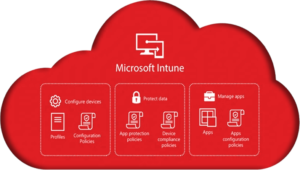In a previous blog I explained how to deploy a .msi application with Intune. In this blog let me describe the next cool MEM feature – Win32 application deployment.
Intune supports Win32 x86 and x64 applications meaning you can deploy, from Intune, any application like Adobe Reader, Google Chrome, 7-zip, etc. You can deploy from a command line in silent mode. You just need to know parameters for .exe or .msu for silent installation.
Before uploading Win32 applications in MEM, you need to “wrap” the app into Intune format (.intunewin) with Microsoft Win32 Content Prep Tool.
Prerequisites:
- Windows 10 1607 or later (Education, Pro or Enterprise)
- Application must not be greater than 8 Gb
- Windows 10 device needs to be enrolled in Intune
- Windows 10 device must be Azure AD joined, Azure AD registered, or Hybrid Azure AD joined
As an example let me show you how to convert and deploy Jabra Direct.
First, we need to have the files for installation and then we can download the Win32 Content Prep Tool from GitHub:
Now run IntuneWinAppUtil.exe from command line:
Specify the folder with your source files for installation and press Enter:
Then specify the setup file and folder for .intunewin file:
Choose N and press Enter. After a couple of seconds, you will find it in the output folder of the converted setup file:
We are ready to publish the Win32 app. Run MEM console and click on Apps – Windows:
Click Add and choose App type – Windows app (Win32):
Click Select. Then we need to provide information about the application we want to publish. Lets start from uploading. Click Select app package file and browse for the .intunewin file we created earlier:
Check the information about the file and click OK:
Next step is to provide very basic information about the application like name, owner, version, etc.:
Provide all the necessary information and click Next. On the next page you need to provide the commands for silent installation and uninstall. I always recommend to do a few tests on a local computer running these commands in cmd to be sure they are correct.
Install behavior – we will install this application for all users that use the device so I leave System by default.
Device restart behavior – “App install may force a device restart” means after successful installation, the app will force your device to restart if needed for finishing the installation process. Determine behavior based on return codes can be an option as well if you want to restart the device based on “successful/failed” return code:
Click Next. On the next page you need to specify minimum system requirements for the application like OS build, free disk space, etc.:
Click Next. On the Detection rules tab you need to specify rules that indicate if the application is already installed. The means Intune will not install this app again if, for example, some files or registry code exist.
Choose Rules format – Manually configure detection rules and click +Add.
Rule type – File
Path – C:\Program Files (x86)\Jabra\Direct4
File or folder – jabra-direct.exe
Detection method – String (version)
Operator – Greater than or equal to
Value – 5.9.55495.0
Associated with a 32-bit app on 64-bit clients – No
Click OK and then Next. On Dependencies tab we can add some applications our application requires and these apps will be installed before our app. I leave it by default and click Next.
On the Supersedence tab we can choose applications our app will supersede, meaning other Win32 apps (up to 10) can be updated, replaced, or uninstalled. Click Next.
I want to make this application available so on the tab Assignments I choose Available for enrolled devices – Add all users:
Click Next, check the summary and click Create:
Then we need to wait until upload process will be completed:
In the next blog I will show you how to check the result! Until then, let us know if we can help further via Email or Phone.





